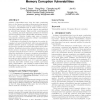58 search results - page 7 / 12 » Detection of New Malicious Code Using N-grams Signatures |
ACSAC
2006
IEEE
15 years 5 months ago
2006
IEEE
Modern malware often hide the malicious portion of their program code by making it appear as data at compiletime and transforming it back into executable code at runtime. This obf...
HIPEAC
2005
Springer
15 years 4 months ago
2005
Springer
Detecting and predicting a program’s execution phases are crucial to dynamic optimizations and dynamically adaptable systems. This paper shows that a phase can be associated with...
HICSS
2007
IEEE
15 years 5 months ago
2007
IEEE
e-business organizations are under constant threat of their business being disrupted by hackers, viruses and a host of malicious attackers. This would lead to loses to the tune of...
SIGSOFT
2007
ACM
15 years 11 months ago
2007
ACM
In this paper, we propose a technique for leveraging historical field failure records in conjunction with automated static analysis alerts to determine which alerts or sets of ale...
CCS
2007
ACM
15 years 5 months ago
2007
ACM
Software vulnerabilities have been the main contributing factor to the Internet security problems such as fast spreading worms. Among these software vulnerabilities, memory corrup...


